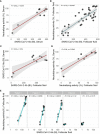Antibodies to SARS-CoV-2 in follicular fluids and their association with assisted reproduction
- PMID: 37006276
- PMCID: PMC10064043
- DOI: 10.3389/fimmu.2023.1120328
Antibodies to SARS-CoV-2 in follicular fluids and their association with assisted reproduction
Abstract
Introduction: Every second woman suffering from infertility asks for medical help. There is public concern that vaccination-induced antibodies (Ab) are negatively associated with fertility. A recent study has demonstrated an association between SARS-CoV-2 vaccination and a lower pregnancy rate in the subsequent 60 days. Consequently, Ab could affect fertility success in assisted reproduction.
Methods: To address this question, we compared fertilization outcomes of vaccinated (n=35) and nonvaccinated (n=34) women. Paired serum samples and multiple follicular fluids (FF) (up to 10 from the same donor) were collected during the course of assisted reproduction and characterized for oocyte quality, the presence of Ab and trace element concentrations.
Results: The results showed a positive correlation of vaccination-induced neutralizing activity of SARS-CoV-2-Ab in serum and FF. On average, Ab concentrations in serum were higher than in the corresponding FF. However, wide variations in SARS-CoV-2 Ab titers were observed between different FF, correlating to trace element levels, even when retrieved from the same donor.
Discussion: Overall, FF contents are highly variable, but no negative association was observed between Ab in serum or FF and fertilization success and oocyte development, supporting the safety of SARS-CoV-2 vaccination during assisted reproduction.
Keywords: COVID-19; fertility; reproduction; selenium; trace elements; woman’s health.
Copyright © 2023 Chillon, Weiss, Demircan, Minich, Schenk and Schomburg.
Conflict of interest statement
Authors GW and MS were employed by Das Kinderwunsch Institut Schenk GmbH. The remaining authors declare that the research was conducted in the absence of any commercial or financial relationships that could be construed as a potential conflict of interest.
Figures




Similar articles
-
Pronounced Trace Element Variation in Follicular Fluids of Subfertile Women Undergoing Assisted Reproduction.Nutrients. 2021 Nov 19;13(11):4134. doi: 10.3390/nu13114134. Nutrients. 2021. PMID: 34836389 Free PMC article.
-
Does mRNA SARS-CoV-2 vaccine in the follicular fluid impact follicle and oocyte performance in IVF treatments?Am J Reprod Immunol. 2022 May;87(5):e13530. doi: 10.1111/aji.13530. Epub 2022 Mar 14. Am J Reprod Immunol. 2022. PMID: 35220640 Free PMC article.
-
Detection of antibodies to SARS-CoV-2 after vaccination in seminal plasma and their association to sperm parameters.Int J Infect Dis. 2023 May;130:161-165. doi: 10.1016/j.ijid.2023.03.018. Epub 2023 Mar 16. Int J Infect Dis. 2023. PMID: 36933610 Free PMC article.
-
Redox Balance and Inflammatory Response in Follicular Fluids of Women Recovered by SARS-CoV-2 Infection or Anti-COVID-19 Vaccinated: A Combined Metabolomics and Biochemical Study.Int J Mol Sci. 2024 Aug 1;25(15):8400. doi: 10.3390/ijms25158400. Int J Mol Sci. 2024. PMID: 39125969 Free PMC article.
-
The negative impact of most relevant infections on fertility and assisted reproduction technology.Minerva Obstet Gynecol. 2022 Feb;74(1):83-106. doi: 10.23736/S2724-606X.21.04870-3. Epub 2021 Jun 17. Minerva Obstet Gynecol. 2022. PMID: 34137567 Review.
Cited by
-
The influence of SARS-CoV-2 vaccination on in vitro fertilization outcomes.Hum Vaccin Immunother. 2025 Dec;21(1):2541495. doi: 10.1080/21645515.2025.2541495. Epub 2025 Aug 3. Hum Vaccin Immunother. 2025. PMID: 40754982 Free PMC article.
-
COVID-19 Vaccines and Assisted Reproductive Techniques: A Systematic Review.J Pers Med. 2023 Aug 4;13(8):1232. doi: 10.3390/jpm13081232. J Pers Med. 2023. PMID: 37623482 Free PMC article. Review.
-
The Effect of COVID-19 and COVID-19 Vaccination on Assisted Human Reproduction Outcomes: A Systematic Review and Meta-Analysis.Diseases. 2024 Sep 3;12(9):201. doi: 10.3390/diseases12090201. Diseases. 2024. PMID: 39329870 Free PMC article. Review.
-
Impact of inactivated COVID-19 vaccination on female ovarian reserve: a propensity score-matched retrospective cohort study.Front Immunol. 2023 Aug 11;14:1198051. doi: 10.3389/fimmu.2023.1198051. eCollection 2023. Front Immunol. 2023. PMID: 37638010 Free PMC article.
References
Publication types
MeSH terms
Substances
LinkOut - more resources
Full Text Sources
Medical
Miscellaneous

